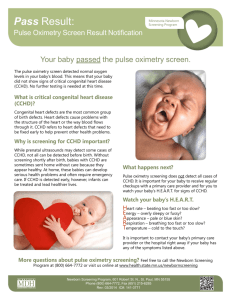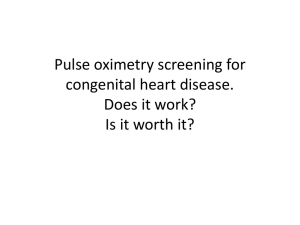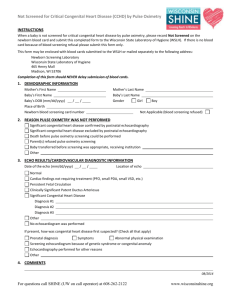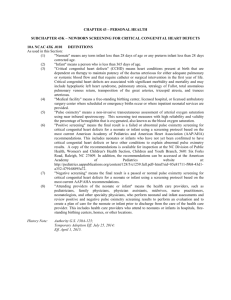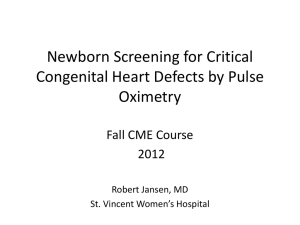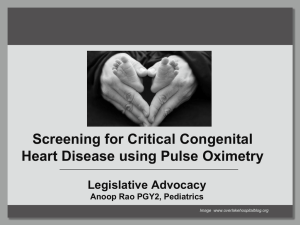Pulse Oximetry Screening for Critical Congenital Heart Defects
advertisement
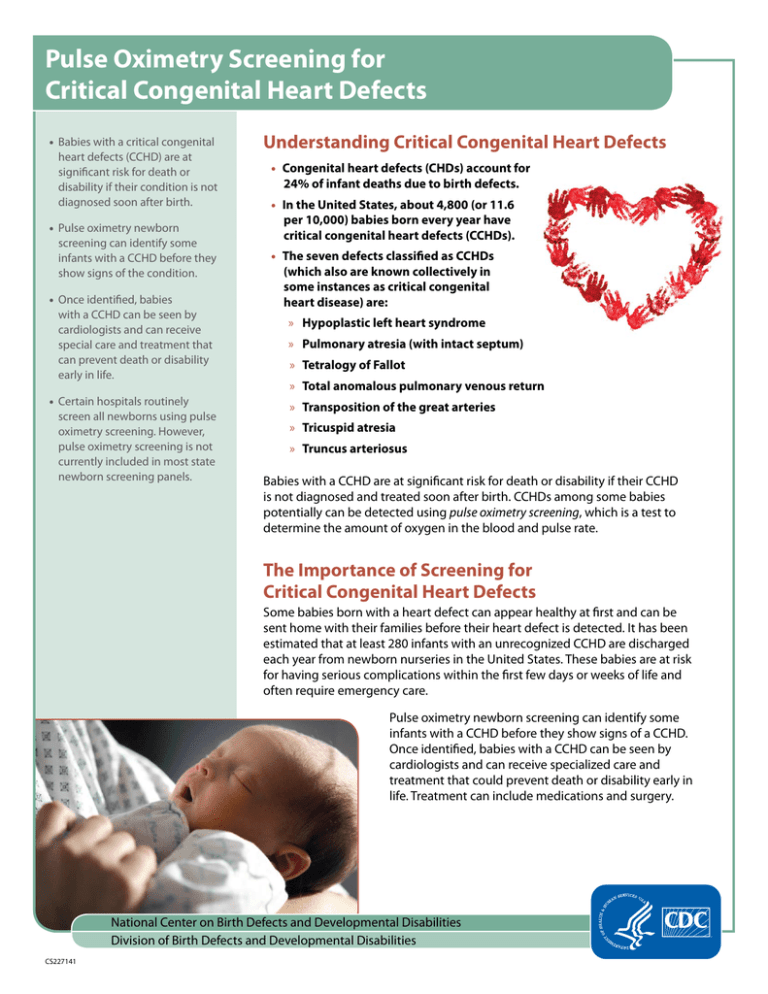
Pulse Oximetry Screening for Critical Congenital Heart Defects •• Babies with a critical congenital heart defects (CCHD) are at significant risk for death or disability if their condition is not diagnosed soon after birth. •• Pulse oximetry newborn screening can identify some infants with a CCHD before they show signs of the condition. •• Once identified, babies with a CCHD can be seen by cardiologists and can receive special care and treatment that can prevent death or disability early in life. •• Certain hospitals routinely screen all newborns using pulse oximetry screening. However, pulse oximetry screening is not currently included in most state newborn screening panels. Understanding Critical Congenital Heart Defects •• Congenital heart defects (CHDs) account for 24% of infant deaths due to birth defects. •• In the United States, about 4,800 (or 11.6 per 10,000) babies born every year have critical congenital heart defects (CCHDs). •• The seven defects classified as CCHDs (which also are known collectively in some instances as critical congenital heart disease) are: »» Hypoplastic left heart syndrome »» Pulmonary atresia (with intact septum) »» Tetralogy of Fallot »» Total anomalous pulmonary venous return »» Transposition of the great arteries »» Tricuspid atresia »» Truncus arteriosus Babies with a CCHD are at significant risk for death or disability if their CCHD is not diagnosed and treated soon after birth. CCHDs among some babies potentially can be detected using pulse oximetry screening, which is a test to determine the amount of oxygen in the blood and pulse rate. The Importance of Screening for Critical Congenital Heart Defects Some babies born with a heart defect can appear healthy at first and can be sent home with their families before their heart defect is detected. It has been estimated that at least 280 infants with an unrecognized CCHD are discharged each year from newborn nurseries in the United States. These babies are at risk for having serious complications within the first few days or weeks of life and often require emergency care. Pulse oximetry newborn screening can identify some infants with a CCHD before they show signs of a CCHD. Once identified, babies with a CCHD can be seen by cardiologists and can receive specialized care and treatment that could prevent death or disability early in life. Treatment can include medications and surgery. National Center on Birth Defects and Developmental Disabilities Division of Birth Defects and Developmental Disabilities CS227141 When and How Babies Are Screened Pulse oximetry is a simple bedside test to determine the amount of oxygen in a baby’s blood and the baby’s pulse rate. Low levels of oxygen in the blood can be a sign of a CCHD. The test is done using a machine called a pulse oximeter, with sensors placed on the baby’s skin. The test is painless and takes only a few minutes. Screening is done when a baby is 24 to 48 hours of age, or as late as possible if the baby is to be discharged from the hospital before he or she is 24 hours of age. Pulse oximetry screening does not replace a complete history and physical examination, which sometimes can detect a CCHD before the development of low levels of oxygen in the blood. Pulse oximetry screening, therefore, should be used to complement the physical examination. Pulse Oximetry Screening Results If the results are “negative” (in-range result), it means that the baby’s test results did not show signs of a CCHD. This type of screening test does not detect all CCHDs, so it is possible to still have a CCHD or other congenital heart defect with a negative screening result. If the results are “positive” (out-of-range result), it means that the baby’s test results showed low levels of oxygen in the blood, which can be a sign of a CCHD. This does not always mean that the baby has a CCHD. It just means that more testing is needed. The baby’s doctor might recommend that the infant get screened again or have more specific tests, like an echocardiogram (an ultrasound picture of the heart), to diagnose a CCHD. Babies who are found to have a CCHD also might be evaluated by a clinical geneticist. This could help identify genetic syndromes associated with CCHDs and inform families about future risks. Centers for Disease Control and Prevention Activities The Centers for Disease Control and Prevention (CDC) is part of the U.S. Department of Health and Human Services (HHS) Secretary’s Advisory Committee on Heritable Disorders in Newborns and Children (SACHDNC). SACHDNC was authorized by Congress to provide guidance to the HHS Secretary about which conditions should be included in newborn and childhood screening programs, as well as how systems should be developed to ensure that all newborns and children are screened and, when necessary, receive appropriate follow-up care. SACHDNC recommended that the HHS Secretary add pulse oximetry screening for CCHDs (i.e., the heart defects listed previously) to the Recommended Uniform Screening Panel. In September 2011, HHS Secretary Sebelius approved adding CCHD to the Recommended Uniform Screening Panel and outlined specific tasks assigned to NIH, CDC, and HRSA. For more information on pulse oximetry screening for CCHDs, please visit http://www.cdc.gov/ncbddd/pediatricgenetics/CCHDscreening.html National Center on Birth Defects and Developmental Disabilities For more information please contact the Centers for Disease Control and Prevention 1600 Clifton Road NE, Atlanta, GA 30333 Telephone: 1-800-CDC-INFO (232-4636)/TTY: 1-888-232-63548 Email: cdcinfo@cdc.gov Web: www.cdc.gov
